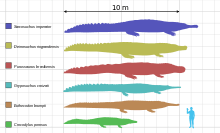Purussaurus
| Purussaurus Temporal range: Miocene | |
|---|---|
| | |
| Skull restoration of P. brasiliensis | |
| Scientific classification | |
| Kingdom: | Animalia |
| Phylum: | Chordata |
| Class: | Reptilia |
| Superorder: | Crocodylomorpha |
| Order: | Crocodilia |
| Family: | Alligatoridae |
| Subfamily: | Caimaninae |
| Genus: | †Purussaurus Rodrigues, 1892 |
| Species | |
| |
| Synonyms | |
| |
Purussaurus is an extinct genus of giant caiman that lived in South America during the Miocene epoch, 8 million years ago. It is known from skull material found in the Brazilian, Colombian and Peruvian Amazonia, and northern Venezuela.
Description

The estimated skull length for one large individual of the type species P. brasiliensis is 1,400 millimetres (55 in).[1] Paleontologists estimate that P. brasiliensis reached around 12.5 metres (41 ft) in length, weighing around 8.4 metric tons (9.3 short tons), with a mean daily food intake of 40.6 kilograms (90 lb).[2] Bite force has been estimated to be around 69,000 N (around 7 metric tons-force).[2] Another estimate gives a smaller size of 10.3 metres (34 ft) in length and 5.16 metric tons (5.69 short tons) in weight.[3] The large size and estimated strength of this animal appears to have allowed it to include a wide range of prey in its diet, making it an apex predator in its ecosystem. As an adult, it would have preyed upon large to very large vertebrates with no real competition from sympatric, smaller, carnivores. Researchers have proposed that the large size of Purussaurus, though offering many advantages, may also have led to its vulnerability. The constantly changing environment on a large geological scale may have reduced its long-term survival, favoring smaller species more resilient to ecological shifts.[2]
Purussaurus is one of the largest known crocodyliformes ever to have existed. Three other extinct crocodyliformes, Sarcosuchus, Deinosuchus, and Rhamphosuchus had similar body sizes. Sarcosuchus and Deinosuchus had similar proportions, but both were geologically much older, dating from the Early and Late Cretaceous, respectively. Rhamphosuchus lived around the same time as Purussaurus, but was slightly smaller, had a more gharial-like snout and lived in India. During the summer of 2005, a Franco-Peruvian expedition (the Fitzcarrald expedition) found new fossils of Purussaurus in the Peruvian Amazon (600 km from Lima).
Analysis of a biomechanical model of the skull of Purussaurus indicated that it was capable of performing the "death roll" maneuver used by extant crocodilians to subdue and dismember their prey.[4][5]
Paleoecology

Brazilian P. brasiliensis is associated with sharks, rays, freshwater teleosts, lungfish, turtles including Stupendemys, crocodilians including Charactosuchus, Gryposuchus, and Mourasuchus, Anhinga birds, and mammals including sloths, bats, rodents, the primate Stirtonia, and river dolphins. River, floodplain, and lake environments were present.[6] Marine and freshwater fish, turtles, crocodilians, and terrestrial and aquatic mammals are associated with Venezuelan P. mirandai. Its environment is described as tropical and coastal. The earlier Colombian P. neivensis lived alongside a massive variety of fauna, including astrapotheres like Granastrapotherium and Xenastrapotherium, the early species of Mourasuchus and Gryposuchus, and the terrestrial crocodyliform Langstonia. This fauna dates from 13 million years ago, in the Laventan stage of the Late Miocene.[1]
References
- 1 2 Aguilera, Orangel A.; Riff, Douglas; Bocquentin‐Villanueva, Jean (2006). "A new giant Purussaurus (Crocodyliformes, Alligatoridae) from the Upper Miocene Urumaco Formation, Venezuela". Journal of Systematic Palaeontology 4 (3): 221–232. doi:10.1017/S147720190600188X. ISSN 1477-2019.
- 1 2 3 Aureliano, Tito; Ghilardi, Aline M.; Guilherme, Edson; Souza-Filho, Jonas P.; Cavalcanti, Mauro; Riff, Douglas (2015). "Morphometry, Bite-Force, and Paleobiology of the Late Miocene Caiman Purussaurus brasiliensis". PLOS ONE 10 (2): e0117944. doi:10.1371/journal.pone.0117944. ISSN 1932-6203.
- ↑ "Size and Palaeoecology of Giant Miocene South American Crocodiles (Archosauria: Crocodylia)"
- ↑ Choi, C. Q. (2014-05-04). "Spinning Slayers: Giant Crocs Used 'Death Rolls' to Kill Dinosaurs". LiveScience.com. Purch. Archived from the original on 2014-05-06. Retrieved 2014-05-06. External link in
|work=(help) - ↑ Blanco, R. E.; Jones, W. W.; Villamil, J. N. (2014-04-16). "The 'death roll' of giant fossil crocodyliforms (Crocodylomorpha: Neosuchia): Allometric and skull strength analysis". Historical Biology: 1. doi:10.1080/08912963.2014.893300.
- ↑ Bocqentin, J., and Melo, J. (2006). "Stupendemys souzai sp. nov. (Pleurodira, Podocnemididae) from the Miocene–Pliocene of the Solimões Formation, Brazil." Revista Brasileira de Paleontologia 9(2): 187–192.
- Rodrigues, J.B. 1892. "Les reptiles fossils de la Vallée de L’Amazone". Vellosia, Contribuições do Museu Botânico do Amazonas 2:41-60.
- Langston, W. 1965. "Fossil crocodilians from Colombia and the Cenozoic history of the Crocodilia in South America". University of California Publications in Geological Sciences 52:1-169.